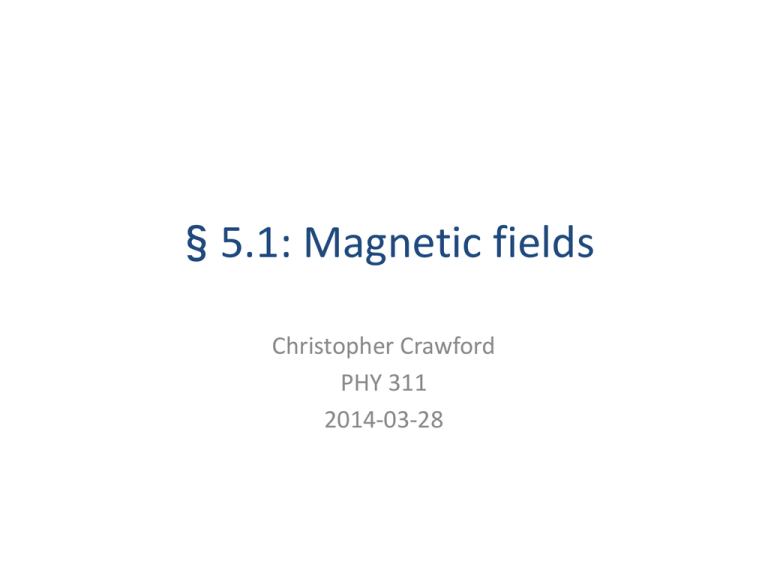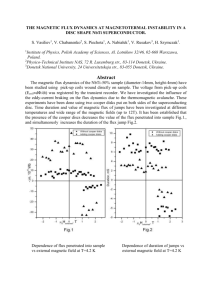lecture
advertisement

§5.1: Magnetic fields Christopher Crawford PHY 311 2014-03-28 Outline • • • • • Introduction to magnetism History of magnetism Magnetic fields Review: current Lorentz force 2 Magnetic scalar potential Electrostatics – Coulomb’s law B.C.’s: Magnetostatics – Biot-Savart law Flux lines bounded by charge Flow sheets continuous (equipotentials) Flux lines continuous Flow sheets bounded by current 3 Equations of Electrodynamics 4 History of magnetism • The magnetic force was known in antiquity – Magnetism more predominant in nature but more difficult to quantify: 1. 2. 3. 4. Permanent magnets (magnetization), not electric currents No magnetic (point) charge (monopole) –> dipole effect (N,S poles) 1-d currents instead of 0-d charges –> can’t split a wire! Static electricity produced in the lab long before steady currents • Timeline (from “A Ridiculous Brief History of Electricity and Magnetism”) – – – – – – – 600 BC 1200 AD 1259 AD 1600 AD 1742 AD 1820 AD 1820 AD 1820 AD 600 BC Thales of Miletus discovers lodestone’s attraction to iron 1200 AD Chinese use lodestone compass for navigation 1259 AD Petrus Peregrinus (Italy) discovers the same thing 1600 AD William Gilbert discovers that the Earth is a giant magnet 1742 AD Thomas LeSeur shows inverse cube law for magnets 1820 AD Hans Christian Ørsted discovers that current twists magnets Andre Marie Ampere shows that parallel currents attract/repel Jean-Baptiste Biot & Felix Savart show inverse square law 5 Magnetic fields • In magnetism it is more natural to start with the concept of “Magnetic field” than the actual force law! (dipole) • Compass aligns with B-field • Iron filings line up along magnetic field lines • Magnetic field lines look like an electric dipole (in fact the magnetic dipole was discovered first!) 6 Difference between E, B dipoles • Same as the differences between Flux and Flow! • Charge = sources of flux • Continuous field lines [flux] • Conservative flow [potential] • Rotational (source of flow?) • Example: Amber (electric) • Example: Lodestone (magnet) – Rub to charge – 2 charges (+/–) “monopole fluids” – Exerts force on charges – Always charged – 2 poles (N/S) “inseparable dipole” – Exerts torque on other magnets 7 First connection to currents: • from Wittaker, “A history of the theories of Aether and Electricity” 8 The current connection • There is no magnetic monopole – N/S cannot be separated • The source of all magnetism is electric current – A dipole is just a current loop • Hans Christian Ørsted – Current produces B-field – Quantified by Biot & Savart 9 Hans Christian Ørsted: • from Wittaker, “A history of the theories of Aether and Electricity” 10 Electrodynamics • Andre Marie Ampere shows that parallel currents attract and antiparallel currents repel • The magnetic force is the basis for electromagnetic units 11 Current elements • Analogous to charge elements – different dimensions • Relations between charge / current and different dimensions – analogy: multi-lane highway – current flux 12 Continuity equation • Local conservation of charge • Current I is a flux; current density J = flux density • 4-vector current 13 Lorentz force 14






